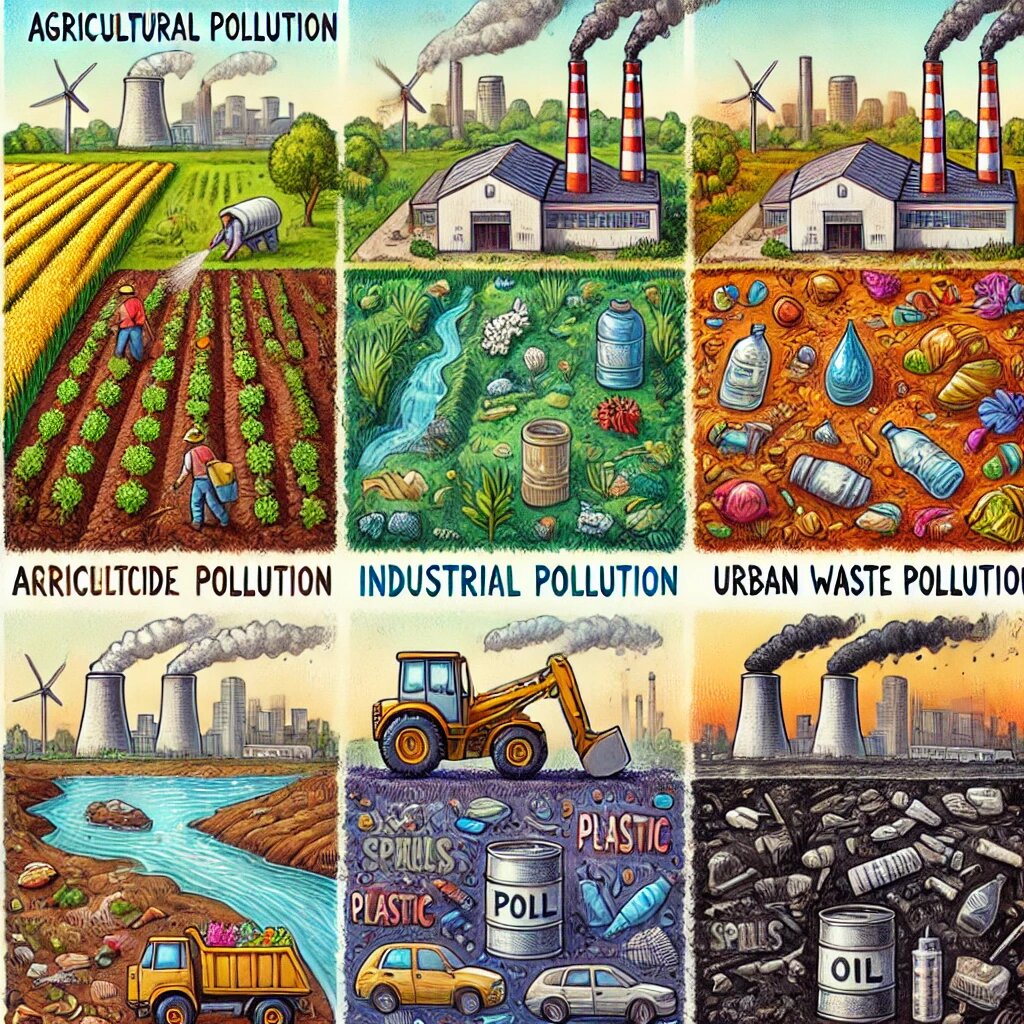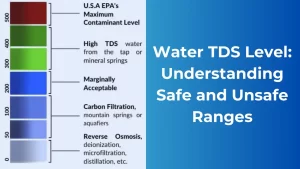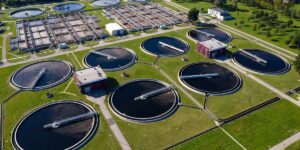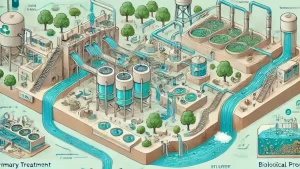This invisible affliction appears when the concentration of pollutants on the surface becomes so high that it harms land biodiversity and endangers health, particularly through food. Activities such as stock breeding and intensive farming use chemicals, pesticides and fertilisers that pollute the land, just as happens with heavy metals and other natural and man-made chemical substances.
Soil pollution is a global threat that is particularly serious in regions like Europe, Eurasia, Asia and North Africa, as indicated by the Food and Agricultural Organization of the United Nations (FAO). The FAO also affirms that both intense and even moderate degradation is already affecting one third of the world’s soil. Moreover, recovery is so slow that it would take 1,000 years to create a few centimetres layer of arable soil.
Also Read: What are KLD and MLD in Water and Wastewater Treatment?
Types of Soil Pollution
Soil pollution occurs when harmful substances contaminate the soil, affecting its quality and fertility. It poses serious threats to agriculture, human health, and the environment. There are several types of soil pollution based on the sources and nature of contaminants.
1. Agricultural Pollution
Agricultural pollution is the contamination of the environment from farming practices. It can include air, water, and soil pollution.
2. Industrial Pollution
Industrial pollution is the contamination of the environment by harmful substances released from factories and other industrial activities. It can pollute the air, water, and land.
3. Urban Pollution
Urban pollution is the introduction of harmful substances into cities, which can impact the environment, wildlife, and human health. It can include air pollution, water pollution, soil pollution, and noise pollution.
4. Biological Pollution
Biological pollution is the introduction of non-native species into an environment, or the release of substances from humans, animals, and birds into the environment.
5. Deforestation-Induced Pollution
Deforestation-induced pollution is the pollution of soil, water, and the atmosphere that results from deforestation.
6. Radioactive Pollution
Radioactive pollution is the release of radioactive substances into the environment, which can harm living organisms and the environment.
Here are 10 Common Causes of Soil Pollution
- Industrial Waste: Factories release toxic chemicals, heavy metals, and hazardous waste that seep into the soil.
- Agricultural Activities: Excessive use of chemical fertilizers, pesticides, herbicides, and insecticides pollutes the soil.
- Deforestation: Clearing forests exposes soil to erosion, leaving it vulnerable to pollutants.
- Urbanization: Rapid urban growth leads to the dumping of plastics, construction debris, and other non-biodegradable waste in the soil.
- Mining Activities: Mining operations leave behind harmful residues like heavy metals, which contaminate the soil.
- Improper Waste Disposal: Discarding untreated municipal waste, including e-waste and sewage, pollutes the soil.
- Oil Spills: Leakage during transportation or drilling contaminates soil and nearby ecosystems.
- Acid Rain: Acid rain caused by air pollution alters soil pH, reducing its fertility and increasing contamination levels.
- Industrial Accidents: Leaks or spills during the production, storage, or transportation of chemicals can heavily pollute the soil.
- Improper Irrigation Practices: Over-irrigation or use of polluted water can lead to soil salinization and contamination.
Effects of Soil Pollution on Agriculture
Soil pollution significantly affects agriculture by reducing the soil’s productivity and fertility, ultimately impacting crop yields and food security. Here are the key effects:
- Loss of Soil Fertility: Contaminants like heavy metals, pesticides, and chemicals disrupt the natural nutrient balance of the soil, making it less fertile and unsuitable for farming.
- Toxicity in Crops: Polluted soil can absorb harmful substances, which plants then take up. This contamination can lead to toxic crops, posing health risks to consumers.
- Reduced Crop Yield: Soil pollution affects plant growth by altering its structure, pH, and water-holding capacity, resulting in lower crop productivity.
- Disruption of Microbial Activity: Healthy soil relies on microorganisms for decomposition and nutrient cycling. Pollutants kill these beneficial microbes, further degrading the soil’s health.
- Soil Erosion: Polluted soil is often loose and unable to retain nutrients, leading to increased erosion and further loss of agricultural land.
- Groundwater Contamination: Pollutants from soil can leach into groundwater used for irrigation, spreading the contamination further and affecting future farming cycles.
- Salinization: Overuse of contaminated water or improper irrigation practices can lead to soil salinity, making the land barren.
- Increased Dependence on Chemicals: As soil fertility decreases, farmers rely more on synthetic fertilizers, perpetuating a cycle of pollution and dependency.
- Reduction in Biodiversity: Soil pollution harms earthworms, insects, and other organisms essential for healthy soil, leading to ecosystem imbalances.
- Economic Losses: Declining productivity forces farmers to invest more in fertilizers, pesticides, and alternative solutions, leading to financial strain.
Types of Soil Pollution Diagram
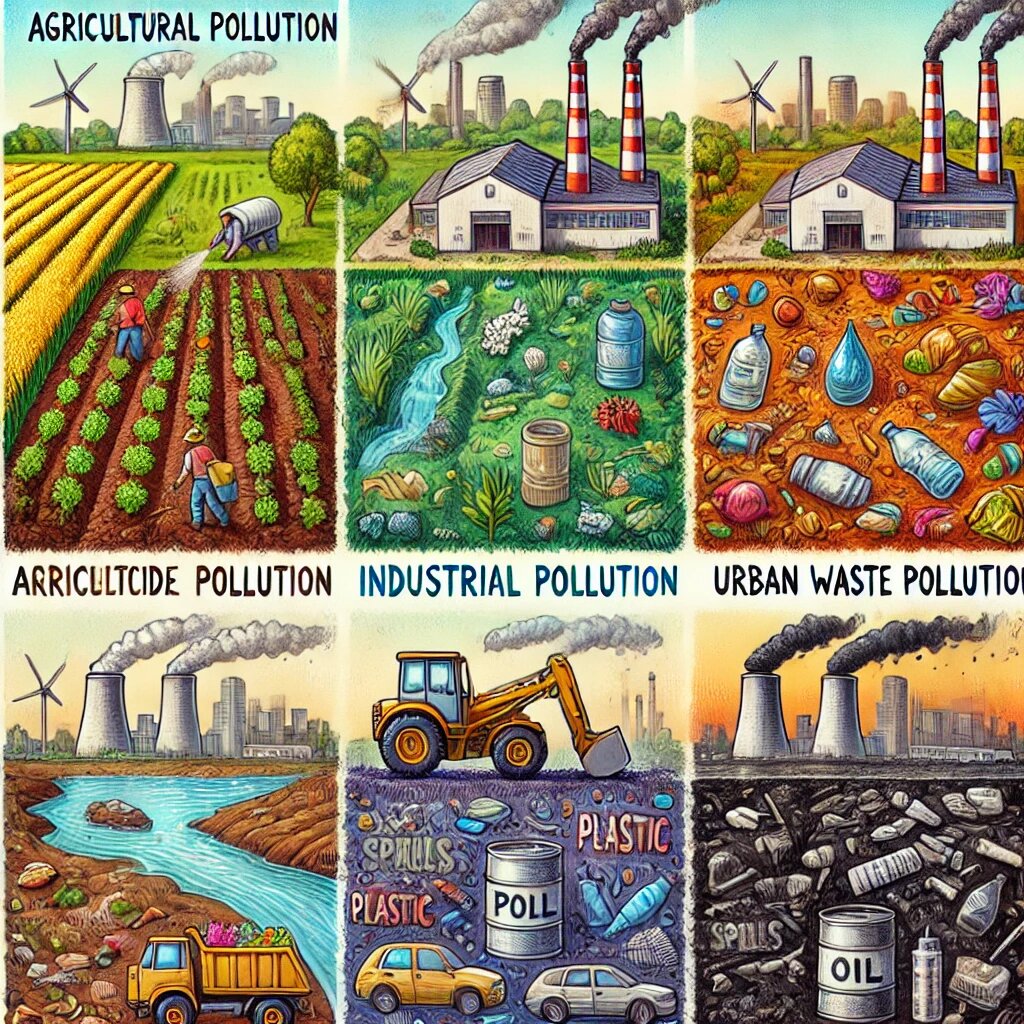
Soil pollution is categorized based on the sources and nature of the contaminants. The primary types include:
- Agricultural Pollution
- Sources: Excessive use of chemical fertilizers, pesticides, herbicides, and insecticides in farming.
- Impact: Depletes soil fertility, kills beneficial organisms, and introduces toxins into crops.
- Industrial Pollution
- Sources: Disposal of industrial waste, heavy metals, chemicals, and hazardous substances from factories.
- Impact: This leads to the accumulation of toxic compounds, making soil unsuitable for agriculture or habitation.
- Urban Waste Pollution
- Sources: Dumping of plastics, untreated sewage, garbage, and electronic waste.
- Impact: Non-biodegradable waste clogs the soil, altering its structure and fertility.
- Oil Spills
- Sources: Leakage during oil drilling, transportation, or accidents.
- Impact: Prevents water absorption by the soil and kills plants and microorganisms.
- Deforestation-Related Pollution
- Sources: Loss of vegetation due to logging or land clearing for construction or farming.
- Impact: Exposes soil to erosion, reducing its quality and productivity.
- Mining Pollution
- Sources: Mining activities leave behind harmful residues and heavy metals in the soil.
- Impact: Destroys soil structure and introduces long-lasting contaminants.
- Acid Rain Pollution
- Sources: Air pollutants like sulfur dioxide and nitrogen oxides react with water to form acid rain.
- Impact: Alters soil pH, reducing fertility and harming crops.
- Radioactive Contamination
- Sources: Improper disposal of nuclear waste or leaks from nuclear plants.
- Impact: Causes long-term soil damage and poses severe health risks.
- Salinization
- Sources: Over-irrigation and use of polluted water for farming.
- Impact: Accumulates salt in the soil, making it unfit for cultivation.
- Plastic Pollution
- Sources: Discarded plastics and microplastics from urban and rural areas.
- Impact: Clogs soil pores and prevents proper aeration and water absorption.
How to Control Soil Pollution
Soil pollution significantly threatens agriculture, human health, and the environment. Implementing preventive measures and sustainable practices can help mitigate the problem. Here are 10 effective ways to control soil pollution:
1. Promote Organic Farming
The Government of India promotes organic farming through schemes like Paramparagat Krishi Vikas Yojana (PKVY) and Mission Organic Value Chain Development for North Eastern Region (MOVCDNER). These schemes provide support to farmers from production to marketing.
2. Practice Crop Rotation and Sustainable Agriculture
Crop rotation is a key practice in sustainable agriculture that helps to manage pests and diseases, improve soil fertility, and increase crop yields.
3. Proper Waste Management
- Proper waste management involves reducing, reusing, recycling, and composting waste.
- Reduce Buy fewer unnecessary items and Choose products with minimal packaging.
4. Control Industrial Emissions
Industrial pollution can be controlled by using sustainable practices, reducing waste, and using treatment systems.
- Install advanced filtration systems in factories to reduce harmful waste discharge.
- Promote zero-liquid discharge (ZLD) practices in industries.
5. Recycle and Reuse Materials
Reusing involves finding new uses for items without changing their original form. Recycling involves converting waste materials into raw materials for new products. Both reusing and recycling can help conserve natural resources and reduce pollution.
6. Implement Afforestation and Reforestation
To implement afforestation and reforestation, you need to identify suitable land areas that were previously forested but now deforested (for reforestation) or land that has never been forested (for afforestation), conduct thorough site assessments, select appropriate tree species based on the local climate and soil conditions, prepare the land, plant tree seedlings, provide necessary post-planting care like watering and weed control, monitor the growth and health of the trees, and engage local communities to ensure long-term sustainability; this often involves collaborating with government agencies, environmental organizations, and landowners to secure land access and funding for large-scale projects.
7. Minimize Chemical Usage
To minimize chemical usage, you can reduce your use of chemicals, store them safely, and dispose of them properly.
- Use eco-friendly alternatives for cleaning products and fertilizers.
- Adopt integrated pest management (IPM) to reduce the dependency on chemicals.
8. Encourage Public Awareness
You can encourage public awareness by using a variety of methods, including events, media, and social media. Events Host educational events, Participate in community events, and Organize fundraising events. Media Contact local news outlets, Use radio, Produce audio-visual material, and Use wireless communication.
9. Control Urbanization and Construction Waste
To control urbanization and construction waste, key strategies include implementing strict regulations on construction practices, promoting sustainable building materials and design, encouraging waste reduction through reuse and recycling, proper waste segregation at the source, and enforcing effective disposal mechanisms, all while prioritizing proper urban planning to minimize the need for large-scale demolition and redevelopment.
10. Enforce Environmental Laws and Policies
Environmental laws are enforced by various government agencies and organizations. The goal of environmental laws is to protect the environment and reduce the impact of human activities.
About R&J Waste Water Treatment Organization
R&J wastewater treatment Organization is the best leading manufacturers & suppliers in India. We have well experienced experts. We provide a wide range of services like Sewage Treatment Plant Manufacturer, Effluent treatment plant, Water Softener Plant, Water Softener Plant for Apartment and more.
We customize our services to meet the exact requirements of our customers at an affordable cost. We offer fully-automatic and semi-automatic plants based on our customer’s requirements.
Soil pollution poses a significant threat to agriculture, biodiversity, and public health. However, with proper waste management, sustainable farming, and strict industrial regulations, we can reduce soil contamination and protect our environment. Awareness and proactive measures are essential to ensure that soil remains a valuable resource for generations to come.

